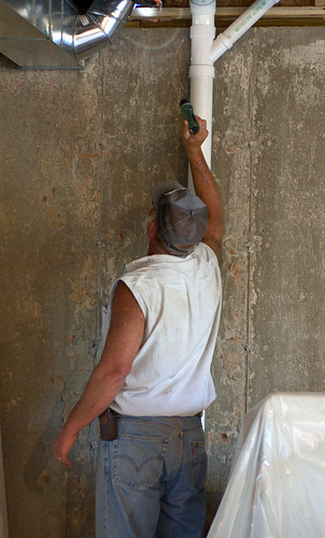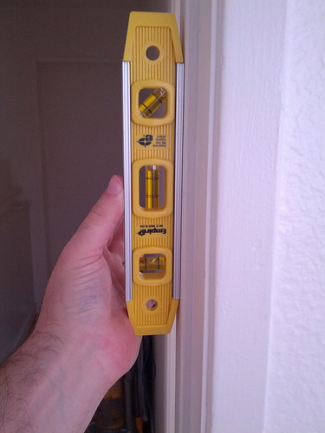How to Identify a Money Pit of a House

If you’re shopping for a new home (or thinking of putting your own on the market) you need to know what marks the difference between a fixer-upper and a complete disaster. There are countless changes you can make to a home to improve it aesthetically or practically, but there are also major potential dealbreakers that you need to be on the lookout for. These problems are signs that it’s not just a fixer-upper – it’s a money pit.
When you’re looking at homes, bring along your home-checking kit: a flashlight, a carpenter’s level, a marble (yes, like one from a Chinese checkers set), and binoculars. You’ll also want to wear comfortable clothes and shoes that you don’t mind getting dirty, because you may need to crawl around a bit under the house to find the most extreme problems. Ready to take a look? Let’s start from the outside.
Is Anything Obviously Wrong Outside?
Surprisingly, many home-seekers miss this step entirely, even though it’s as easy as checking the house out from a distance. You want to check out the roof for any signs that it’s sagging or damaged (if you think the roofline might be sagging but can’t tell, compare it to the neighbor’s roof), and the exterior features, including doors, windows, foundation, walls, and porch for any crookedness.
 If you see a sagging roof, it means that it’s been damaged by bearing too much weight over time, either because there are too many layers of shingles, or because the owner hasn’t handled heavy snowfall properly. When a roof sags, snow isn’t able to melt as quickly, which can cause ice dams and more damage to the roof materials.
If you see a sagging roof, it means that it’s been damaged by bearing too much weight over time, either because there are too many layers of shingles, or because the owner hasn’t handled heavy snowfall properly. When a roof sags, snow isn’t able to melt as quickly, which can cause ice dams and more damage to the roof materials.
If you see any other obvious problems with crookedness outside the house, you’re probably looking at a problem with the foundation. Foundation problems are among the most severe and expensive issues a house can throw at you, and they’re more common in older houses. They’re also a problem that’s easily missed by inexperienced home buyers.
Are the Floors and Doors Straight?
Once inside the house, check for sloping floors. The slope may be immediately obvious to you as you follow the real estate agent through the house; you may notice that the floor feels elevated in one section but not another, or that you keep scuffing your feet against a slight rise you don’t expect.
 Notice how the floor feels beneath doorways and other arched areas; humps in those areas can mean a support has failed somewhere beneath. Your marble and your carpenter’s level are your friends here. Set the marble down on a hardwood floor to see if it rolls, indicating a slanted floor, and use the carpenter’s level on carpeted areas.
Notice how the floor feels beneath doorways and other arched areas; humps in those areas can mean a support has failed somewhere beneath. Your marble and your carpenter’s level are your friends here. Set the marble down on a hardwood floor to see if it rolls, indicating a slanted floor, and use the carpenter’s level on carpeted areas.
Check all the doors and windows to see if they stick, and look to see if the doors fit squarely. If there are big gaps between the top and bottom of the door, or you can see that the door has been altered to fit a crooked space, that’s an indicator that the foundation or the structural support of the house is damaged.
Has Water Invaded?
As you tour the house, be aware of any unusual smells that might indicate mold or dampness. Check under bathroom and kitchen fixtures for any sign of water stains, mold, or other water damage. You’ll also want to take a hard look (and a deep smell) around the basement and attic, two very common places for water damage to occur unnoticed. In the basement, take a look at the primary sump pump or battery backup sump pump, if there is one installed; check for a sticker or information card from the plumbing company who installed or serviced them. They might have valuable knowledge about the property’s basement water damage history.
Many homeowners are completely unaware of water damage and rot in their homes, or they may not realize how serious these problems can get. For this reason, many simply cover up water damage with a fresh paint job or a fast remodel and forget about it – but the damage is still there underneath. Check for these types of repairs with your flashlight. By holding it parallel to the wall, you can often spot irregularities and repair jobs. Ask about them and get information about who made the repair so you can double-check that all is well.
The Fixes
If you find any of these problems, none of them is automatically a dealbreaker. They are, however, problems that you need to follow up on before making an offer on the house.
If you noticed a problem with the roof, you’ll want to find out if it’s a foundation issue or simply roof damage. Either way will cost a pretty penny to repair: a new roof can run $8,000 or more, and a fallen foundation starts at $20,000 - $30,000 if you need to jack up the house in order to repair it.
Issues with sloping floors and ill-fitting doors and windows indicate that there’s either a foundation problem or that one or more of the house’s supports is damaged. If it’s a foundation issue, the cost can run from a full foundation replacement, as above, or a few thousand dollars to repair a slipped foundation.
If a support has been damaged, you’ll want to get an estimate on repairs, because they can vary massively, depending on the type of support and the scope of the damage: anywhere from a few hundred to tens of thousands of dollars.
If nothing is wrong with the foundation or the supports structurally, it may be that one of the supports has slipped or that the house wasn’t built on level supports originally. Repairing this kind of problem starts at about $3,000, and involves jacking up the house.
 Water damage anywhere in the house is the biggest wild card in the bunch. The water damage may be mild and easily fixed if it’s recent damage; if you’re lucky, it’s a quick $50 for materials to fix the leak. If you have long-term water damage, however, there may be rot and mold issues that compromise the integrity of the entire house – which could cost you $100,000 or more to repair. If you find water damage, seek an expert to find out exactly what you’re dealing with.
Water damage anywhere in the house is the biggest wild card in the bunch. The water damage may be mild and easily fixed if it’s recent damage; if you’re lucky, it’s a quick $50 for materials to fix the leak. If you have long-term water damage, however, there may be rot and mold issues that compromise the integrity of the entire house – which could cost you $100,000 or more to repair. If you find water damage, seek an expert to find out exactly what you’re dealing with.
If you’re in love with the house and willing to repair big problems like these, be sure to negotiate the price accordingly. Get an inspector’s report and ask a real estate agent (not the seller’s) what a reasonable price knock-down would be. If you have the time and energy to lay a new foundation on a lovable old home, you can tackle that job – but at least you’ll know exactly what you’re getting into from the start.
Image Sources: trenttsd/Brittany Lynne, CAHairyBear, wdd, Gramody
